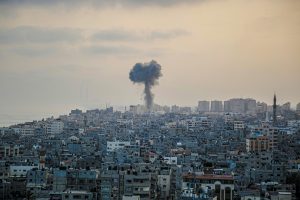The human catastrophe in Gaza over the past 12 months has shone a spotlight on Australia’s responses to the growing number of mass atrocities overseas. A recent University of Sydney study suggests that with rare exceptions, foreign crises involving atrocity crimes remain a low priority for both media reporting and public policy deliberations.
Titled “Australian Foreign Policy, the Media and Responses to Mass Atrocities,” the study examines key factors likely to influence the relationships between Australian public opinion, media, and policymakers. Past responses (and often the lack thereof) to genocide and other distant atrocities have exposed significant obstacles to public engagement because of, but not exclusively, a lack of political leadership, flawed media coverage, and domestic focus on local policies.
Like most people worldwide, Australians prioritize domestic issues that directly impact their lives, such as jobs, tax, housing and health. Foreign policy topics that capture attention often have domestic implications, such as national security, asylum policies, and key trade deals.
On the other hand, humanitarian crises caused by faraway conflicts rarely garner sustained media or public interest.
Better media coverage in support of a more constructive public engagement with Australia’s policies on foreign atrocities could improve the nation’s response, in keeping with ideas of Australian values and notions of “good international citizenship.”
The Rohingya Crisis
The Rohingya crisis in Myanmar from 2016-2017 is a case in point.
The findings highlight several important dynamics in the opinion-media-policy relationship. Among other things, they point to striking omissions in the media’s coverage and the public and official deliberations over Australia’s policy responses to the events.
For example, the possibility is highlighted that a focus of public discourse on responses to the consequences, or side effects of the crisis, such as refugee intake and humanitarian aid, may have overshadowed discussions of more direct ways Australia could assist in halting the violence itself.
Another factor looked at was the extent to which modest levels of clout and capabilities — diplomatic, economic, and military — may have inhibited not only Australian governments’ appetite for more meaningful engagements with foreign crises, but also Australians’ expectations of what action their country could take.
How the Media Could Improve Its Coverage
One shortcoming in media coverage is the failure of journalists to include in their reporting additional policy options to those suggested by the government of the day on how Australia could, and should, respond to such situations. For example, these alternatives may be raised in the public domain by human rights NGOs, which often struggle nowadays to gain media access and visibility for their early warning alerts, risk analyses, and policy recommendations.
Broadening the spectrum of media sources would thus enrich the public debate.
This doesn’t necessarily mean that better quality media coverage and public engagement could alone affect and lead to more effective and meaningful policies. Other factors may influence Australia’s responses and, consequently, its good international citizenship record.
One other way of improving Australia’s responses could involve increased collaboration with other like-minded middle powers in the region and further afield. Taking leadership over global challenges insufficiently addressed by the big powers is what middle powers such as Australia have done in the past, and forming alliances with other middle powers will increase both the legitimacy and effectiveness of these endeavors.
A more meaningful discussion of Australia’s policy responses would also require a change to the bipartisan practice of avoiding public challenges to government foreign policies by the main federal opposition party. While this practice did manifest in relation to the Rohingya crisis, it was a different story when it came to the situation in Gaza.
Different Attitudes to the Rohingya and Gaza Crises
There were clearly visible differences in Australians’ responses to the situation in Gaza compared to the Rohingya crisis. The most significant are the profound divergences in public attention, visibility, actions, and media coverage.
Gaza has been on the news daily for a year. This attention is sustained by a stream of related stories: weekly pro-Palestine demonstrations in Australia’s capital cities, tensions around the pro-Palestinian encampments in major university campuses, significant increases in both antisemitic and Islamophobic incidents, political opposition contestations (from both sides) of the Albanese government’s statements and policies, and other stories.
The response to the Rohingya crisis, on the other hand, was marked by an absence of any of these. The lack of significant Burmese or Rohingya diaspora communities in Australia, along with the enduring global focus and preoccupation with the Holy Land (at times to the detriment of other less visible but not necessarily less violent or destructive crises), would help explain some of the differences.
Still, further research would be needed to grow our understanding of other differences and similarities between Gaza, the Rohingya, and other crises, especially on the nature and influences of media coverage and public engagement with Australia’s policymaking.
What policies were advanced, by whom, to what purposes, and to what effects? How was the domestic focus divided between the consequences of mass violence and stopping the violence itself, and what was envisaged as feasible for Australia to achieve, individually or in collaboration with other states? These are only some of the many questions still awaiting public attention and scholarly scrutiny.
Originally published under Creative Commons by 360info™.

































